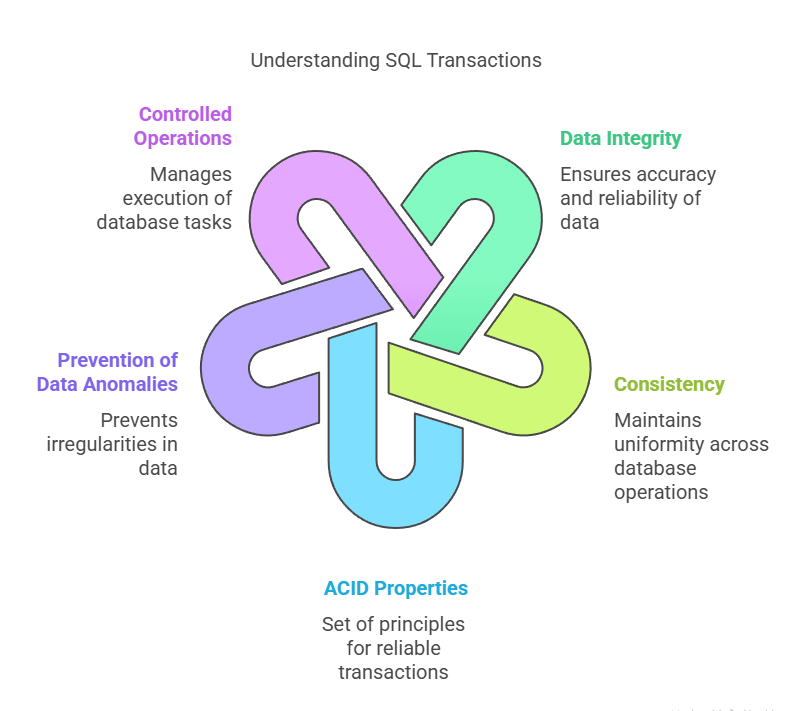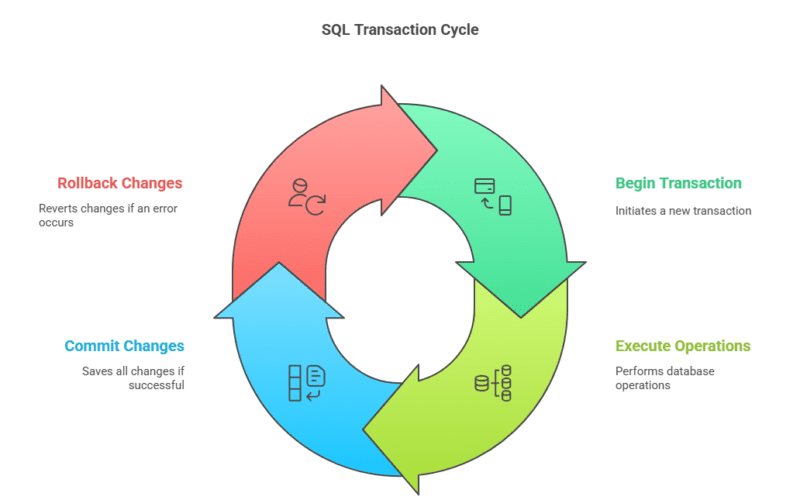Summary: SQL transactions group multiple database operations into a single logical unit of work, ensuring either all changes succeed or none are applied. They adhere to ACID properties—Atomicity, Consistency, Isolation, and Durability. Commands like BEGIN, COMMIT, and ROLLBACK control transaction execution. Examples include banking transfers and inventory management.
Introduction to SQL Transactions
SQL transactions are a crucial concept in database management systems, particularly in relational databases like MySQL, PostgreSQL, and SQL Server. They allow multiple operations to be executed as a single, logical unit of work, ensuring that either all changes are applied or none are, thereby maintaining data integrity and consistency.
This is especially important in applications where data accuracy is paramount, such as financial systems, inventory management, and e-commerce platforms.
SQL transactions are controlled using specific commands like BEGIN TRANSACTION, COMMIT, and ROLLBACK. These commands enable developers to manage transactions effectively, ensuring that database operations are reliable and consistent.
Key Takeaways
- SQL transactions ensure data integrity by grouping multiple operations into a single unit of work.
- They prevent inconsistencies in critical applications like e-commerce, healthcare, finance, telecommunications, and social media.
- Commands like COMMIT and ROLLBACK control transaction success or failure based on conditions.
- Transactions enhance operational efficiency by maintaining accurate records across industries.
- Real-world examples demonstrate their versatility in solving complex business challenges.
Importance of SQL Transactions

SQL transactions are critical for ensuring data integrity, consistency, and reliability in relational databases. They allow multiple SQL operations to be grouped into a single logical unit of work, ensuring that either all changes are applied or none are, thereby preventing partial updates and maintaining the database’s structural integrity. Here’s why SQL transactions are indispensable:
Data Integrity
Transactions ensure that data remains consistent by preventing partial updates. If any part of a transaction fails, the entire transaction is rolled back, maintaining the database’s original state.
Reliability
In environments where multiple users interact with the database simultaneously, transactions prevent interference between concurrent operations, ensuring each transaction executes independently.
Error Handling
Transactions provide a robust error-handling mechanism. If an error occurs during a transaction, the ROLLBACK command can undo all changes, preventing data corruption.
ACID Properties of Transactions

SQL transactions adhere to the ACID properties, which are fundamental for ensuring the reliability and consistency of database operations:
Atomicity
Ensures that all operations within a transaction are treated as a single, indivisible unit. If any operation fails, the entire transaction is aborted, and all changes are rolled back.
Consistency
Guarantees that the database remains in a valid state before and after the transaction. This means that transactions must follow the rules defined by the database, such as constraints and triggers.
Isolation
Prevents interference between concurrent transactions, ensuring they execute independently. This property ensures that the outcome of a transaction is not affected by other transactions running at the same time.
Durability
Ensures that once a transaction is committed, its effects are permanent and survive even in the event of a system failure.
These properties make SQL transactions reliable for handling complex operations in multi-user environments.
SQL Transaction Commands
SQL transaction commands are essential for managing and controlling the execution of operations within a database. They ensure data integrity, consistency, and reliability by grouping multiple SQL statements into a single logical unit of work.
These commands allow developers to start, commit, or roll back transactions based on the success or failure of operations. Below is an overview of the key SQL transaction commands, their syntax, and examples.
BEGIN TRANSACTION
Starts a new transaction. All subsequent operations are part of this transaction until a COMMIT or ROLLBACK is executed.
COMMIT
Saves all changes made during the transaction permanently to the database. Once committed, changes cannot be rolled back.
ROLLBACK
Undoes all changes made during the transaction since the last BEGIN TRANSACTION. This command is used when an error occurs or if the transaction needs to be aborted.
SAVEPOINT
Creates a point within a transaction to which you can later roll back. This allows partial rollback of a transaction without affecting earlier changes.
ROLLBACK TO SAVEPOINT
Rolls back the transaction to a specific savepoint without affecting earlier changes.
Example of a SQL Transaction
Bank Transfer Example
Consider transferring $500 from Account A to Account B in a banking system:
If an error occurs (e.g., insufficient funds), the transaction can be rolled back, ensuring that either both updates succeed or neither is applied, maintaining consistency.
Real World Applications

SQL transactions are a cornerstone of database management systems, ensuring data consistency and reliability in critical operations across industries.
They group multiple SQL statements into a single logical unit of work, guaranteeing that either all changes are applied or none are, thereby preventing inconsistencies. Here are some compelling real-world applications of SQL transactions in various industries:
E-commerce
SQL transactions play a vital role in managing inventory and processing orders in e-commerce platforms. For instance:
- Inventory Management: When a customer places an order, SQL transactions ensure that the inventory is updated and the order is recorded simultaneously. If an error occurs (e.g., insufficient stock), the transaction is rolled back to maintain consistency.
Benefits: Ensures accurate stock levels, prevents overselling, and maintains customer satisfaction.
Healthcare
In healthcare, SQL transactions are used to manage sensitive patient data and streamline operations:
- Patient Records: Transactions ensure that updates to medical histories and treatment plans occur without data loss or corruption.
Example: Identifying patients overdue for screenings.
Benefits: Enhances efficiency in preventive care and ensures accurate reporting.
Finance
SQL transactions are indispensable in financial institutions for managing accounts and detecting fraud:
- Fund Transfers: Transactions ensure that debits from one account and credits to another occur simultaneously.
- Fraud Detection: SQL queries identify unusual transaction patterns for further investigation.
Example: Detecting large transactions above average amounts.
Benefits: Prevents financial discrepancies and ensures compliance with regulations.
Telecommunications
Telecom companies use SQL transactions to analyze network performance and optimize resources:
- Network Optimization: Transactions identify areas of congestion and allocate bandwidth dynamically.
Example: Identifying high traffic segments for optimization
Benefits: Improves service reliability and customer satisfaction.
Social Media Platforms
Social media networks rely on SQL transactions to manage user data efficiently:
- Post Management: Transactions ensure that posts are stored correctly while updating user activity logs.
- Message Retrieval: SQL queries facilitate seamless access to stored messages for users.
Example: Managing user posts and activity logs simultaneously
Benefits: Ensures consistent user experience and accurate data tracking.
Conclusion
SQL transactions are essential for maintaining data integrity and consistency in relational databases, especially in critical applications like finance, e-commerce, and healthcare.
By grouping multiple operations into a single logical unit of work, SQL transactions ensure that either all changes succeed or none are applied, preventing partial updates and errors.
With commands like BEGIN, COMMIT, and ROLLBACK, developers can manage transactions effectively while adhering to ACID properties.
Ready to master SQL and database management? Join Pickl.AI’s Data Science courses today and gain hands-on experience with SQL transactions through practical examples and real-world applications!
Frequently Asked Questions
What is an SQL Transaction?
An SQL transaction is a sequence of one or more SQL statements executed as a single unit of work to ensure either all operations succeed or none are applied, maintaining data integrity.
How do ACID Properties Ensure Reliable Transactions?
ACID properties (Atomicity, Consistency, Isolation, Durability) ensure that transactions are error-free, maintain database validity, operate independently in multi-user environments, and persist changes even after system failures.
When Should You Use ROLLBACK in SQL Transactions?
Use ROLLBACK when an error occurs during a transaction to undo all changes made since BEGIN TRANSACTION, ensuring no partial updates compromise data integrity.




